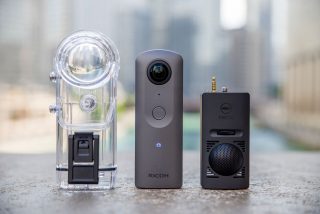 Almost a certain purchase for me. The 4K version of my Theta S 360° camera, the Ricoh Theta V (“vee”, not “five”).
Almost a certain purchase for me. The 4K version of my Theta S 360° camera, the Ricoh Theta V (“vee”, not “five”).
Although my Theta S records in “full HD”, that is not as good as it sounds. The 1920×1080 resolution is for the whole 360° image; at any one time, you would only be looking at a small slice of that pie, so the effective resolution is quite low.
So we have been waiting for the 4K cameras, which would give a normal viewing resolution close to HD, and appear quite respectable. Ricoh lost the lead in this race – there have been about half a dozen 4K 360° cameras out in the last year.
However, I’ve rejected every one I have looked into, as although their resolution is far better than the old Ricoh S, the stitching borders on diabolical. I had great hopes for the Vuze, but on viewing sample videos (which were not released before they started taking pre-orders), the stitching – for me, at least – makes the videos annoying and almost unwatchable. Particularly, as the Vuze has *4* stitching lines, not 2, as with the Theta S.
Enter the Ricoh Theta V. The videos I have seen so far (a month before the device goes on sale – thank you Ricoh!) have a good resolution, and appear to have retained the decent stitching of the Theta S. Yes, if you look, you can sometimes see the stitching, but it tends to be a softening of the focus, rather than a hard split line going through people. You can be sure I am going to be studying more Theta V videos before I decide, but it’s so far, so good.
But not only the picture is improved. The camera has doubled the number of internal microphones to 4, allowing it to produce “Spacial Audio”. What results is a synthesised stereo which fits whatever orientation you are viewing. As you “turn” in the image, the audio moves with it.
This gives Ricoh the opportunity to sell an add-one microphone that is nearly as expensive as the camera itself. But if I read correctly, this is for *improved* sound – you don’t have to have it to get the spacial audio. So I will leave the microphone for now, until I see what the camera’s internal sounds do, and how easy it is to connect my own gear to the 6-pole jack socket.
It also has a rather nifty underwater housing – which appears far better than the “test-tube” hard case they produced for the Theta S, which protected the camera from water, but completely destroyed the image by refraction.
I’ve had great fun with my Theta S, even with its limitations. But I feel a purchase coming on sometime soon. It’s expected in the UK by the end of September.

Alas, checking something out I have noticed that the Theta V still has a time restriction on video recording, which means any long performance will be broken up, with necessary fiddling (either with the device or a phone/tablet) after every 25 minutes. This is the issue that got in my way with the Theta S, the last time I tried to record concerts and performances at a filk-con.
Although there may be ways around this, by streaming to a device and recording on that, I’m not planning to take the risk. I’ve reluctantly cancelled my pre-order.
Once it goes on sale, and more people are trying it and reviewing it, I may reconsider, based on what I learn.